Lwówek Śląski
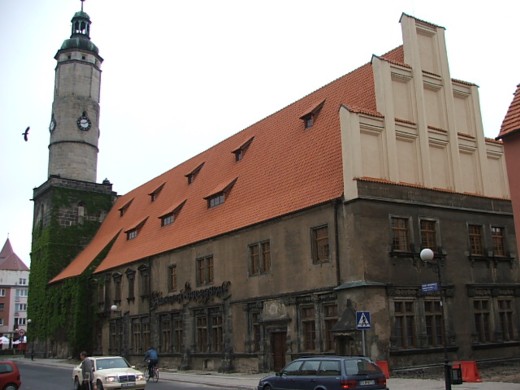
Lwówek Śląski. City Hall seen from the southeast
Distance
Population
9.870
Location and history
Lwówek Śląski is located in the southwestern corner of Poland, in the region of Lower Silesia, on the river Bóbr – one of the larger tributaries to Odra.
Lwówek Śląski is one of the oldest cities in Lower Silesia. Already in the early Middle Ages, Lwówek became a local economic and trade center. The location of a well-known trade route, called Kongevejen, as well as the extraction of gold in nearby Płakowice, also promoted. In 1217, Lwówek was granted the market town rights of Prince Henryk I Brodaty. Only (the nearby ones) Złotoryja and Wleń are older as cities. Lwówek’s founding as a city and the resulting privileges meant the rapid development of the city. Between 1278 and 1286, the city was the seat of Prince Bernard Zwinny and the capital of an independent principality. Since then, the city became part of the Principality of idwidnica-Jawor.
As gold mining ceased, the principal occupations of the inhabitants became crafts, especially dressmaking and weaving, as well as trading and cutting of stones for the construction.
In the 1300s, citizens of Lwówek were granted several privileges: the right to organize peat days and markets, trade in salt, coinage and others. In the town were several craftsmen's pools, the largest of which was the dressmaker's pool. In 1392, Lwówek came under Czech supremacy.
At the beginning of the 17th century. the city numbered over 8 thousand inhabitants. Lwówek had 450 dressmakers and the city's earnings were good. The thirty-year war from 1618 to 1648 marked a tentative end to this positive development. As a result of the war, the city was severely destroyed and its population dropped drastically. Therefore, the city stood throughout almost the 18th century. quiet in its development.

Lubań Tower and the city wall in the western part of the old city
Some improvement at the end of the 18th century. was hampered by the Napoleonic wars. During these wars, Napoleon Bonaparte himself stayed at one point in the city, namely in connection with it “first battle of Bóbr”, Aug. 22, 1813. The so-called “second battle of Bóbr” on August 29 of the same year, ended with a defeat for the French.
Only in the second half of the 19th century. begins some economic progress. Lwówek gets a railway connection with Złotoryja in 1884 and with Gryfów Śląski in 1885. Tourism and cultural life, especially music, are evolving. During the same period, the food industry (brewery) is being developed, which causes several local quarries, a plaster mine, etc.
Although the population increased during the interwar period in the 20th century, the number of industrial companies did not follow.
During the Second World War the city's economic condition deteriorated, and in the final phase of the war, approx. 40% of Lwówek destroyed.
The city was occupied by the Soviet army in the spring of 1945. Immediately after the Polish authorities took over the administration, Lwówek was appointed as the center of a district, which it remained until 1975.
Now Lwówek is the center of an urban and rural municipality that includes the city of Lwówek and 28 villages.
Tourist attractions
Selected attractions:
City Hall (Ratusz)
The beginning of the current town hall building was the Merchants' House, the seat of the local councilors, erected in the middle of the 13th century. by Prince Bolesław Rogatka. In the western part of the building, the lower parts of the walls of the old house are preserved. In the second half of the 14th year. there was an extension of the Merchants' House, which was needed to make room for the barter, which was a new extension of the local government area. It is also known that new construction or extension works were begun in 1520, probably a continuation of the earlier construction project or necessitated by the damage caused by a fire in 1518. Three rooms on the ground floor as well as the barter room on the first floor were covered with rib vaults. The most recent, current form was given the Town Hall in the years 1902-05. The cottages and stalls that had been on the north side were demolished and replaced with an archway for market purposes.
The Town Hall tower was built on the west side and put into operation in 1504. The tower contained a prison, torture chamber and the barter's archive. From the top floor of the tower, the watchmen kept watch over the city life. In addition, they were to check the corridor clock corridor, which was mounted on the tower in 1588. On the wall in the northwest corner of the building is depicted a lion figure with the inscription: “Justus almost leo” (Fair as the lion). This image and the inscription have been transferred to it from the Lubań Gate Tower in connection with the renovation. The barter room as well as the wedding room are beautifully decorated. The Town Hall building today also houses the Regional Museum and the Public Library.
See photo below and at the top of the page.
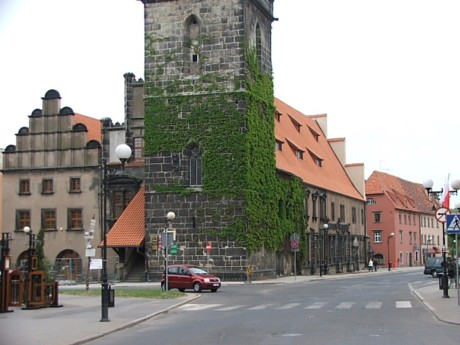
Lwówek Śląski. The town hall with the lower part of the tower seen from the west. (See also photo at the top of the page)
The fortification of the city
The fortification is one of the most interesting of this type in Lower Silesia. It originally consisted of two masonry rings, and much of it is preserved in fairly good condition. The sections of the preserved walls that make the most impression are the sections adjacent to the gate towers. Very specific data for the construction of the fortification of the city are difficult to find in the documents. However, it is known that the city already had defensive walls by the end of the 13th century. In the 14th and early 15th centuries. the city walls must have been quite effective, for it is known that the armies of the Hussites twice – in 1427 and 1432 – had to give up their siege of the city. The open brick towers in the inner wall, which were built with approx. 50 meter gap, was used by arm chesters. The main reinforcement of the medieval system was the second, exterior, murmur, adapted to the use of firearms. The largest and partially preserved roundel in the wall was built in the middle of the 16th century, designed by an architect from Milan. In the 17th century, when the walls no longer had the same military significance, they began to decay. The long-planned demolition of parts of the walls as well as the Złotoryja Gate Tower finally took place at the end of the 19th century, where it was necessary to establish a better connection between the old city and the neighborhoods that had grown up outside the walls. In 1935, the authorities recognized the historical and cultural value of the remaining part of the old fort; it was protected and a thorough preservation work was started. Below, in some places, some reconstruction was also needed, such as in connection with a section of the inner wall of the Lubań Gate Tower. Further preservation of the fortification occurred in 1960’s. In this connection, four of the open brick towers were also taken care of.

Part of the city wall at the Lubań Tower; bottom section of the tower is seen TV. in the picture
Bolesławiec port tower (Wieża Bramy Bolesławieckiej)
As the name indicates, this tower in the Middle Ages was to defend the city gate through which the exit road towards Bolesławiec went, ie. in the northern direction. Probably it is listed at the transition between the 13th and 14th century. It was rebuilt in the 16th century. In connection with the acts of war in 1641, the upper part was destroyed. After the reconstruction, the tower was converted into a prison with torture chamber and dungeon (about 12 m deep). The city wall, with which the tower was built, reached its original height up to the cylindrical part of the tower building, and the doorway to the west was the only entrance from the wall's aisle. The tower, as well as the original tower helmet, was severely damaged during a fire in 1752. In 1850, an entrance was cut into the lower part of the tower and an ice store was set up in the old dungeon. Conservation work began in 1935. A further renovation took place in 1959-60, when the tower was provisionally covered with a flat roof. In 1971-72 several improvements were made: installation of electricity, building of internal and external stairs, etc. An artist workshop was set up in part of the tower. It was not until 1983 that the tower was fitted with an appropriate helmet.

Lwówek Śląski. Bolesławiec port tower
Lubań port tower (Wieża Bramy Lubańskiej)
The tower that formerly guarded the city gate to the west, ie. in the direction towards Lubań, occurred in the 13th century. It was rebuilt in the early 16th century, but already a century later it was in pretty bad condition and in 1616 it collapsed. The tower was rebuilt, at first only the foundation and the walls above the ground. After a break due to the Thirty Years War, the rebuilt tower was fitted with a helmet in 1661. A fire in 1752 caused major damage to the building. The following reconstruction provided the building with cornices and with the round openings in the cylindrical part. In the 19th century, the building was used for archival purposes. During World War II, part of the book collections from the libraries in Wrocław were kept here. A new renovation took place in 1990, after which part of the building was rented out as a café.
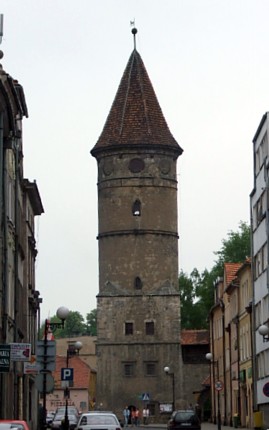
Lwówek Śląski. Lubań port tower
Church of Our Lady of the Assumption (Parish Church) (Kościół Wniebowzięcia NMP)
A wooden church existed in this place as early as the 13th century. It became a parish church when Lwówek gained market town rights in 1217. During Henry V, the church was handed over to the Order of Johannite, a Catholic knighthood. Around the year 1300, the Johannites erected the present church building instead of the wooden church, but in the same place. The building had walls of paving stones. Of this building still stands the west façade in early Gothic style with the two towers, separated by the main portal. After a fire, the rest of the building had to be rebuilt in the first half of the 16th century. and now appears as a three-ship hall church. In the interior of the church you should notice the wooden cross from 1410 hanging in the porch – it is the oldest of its kind in Silesia; also the Renaissance baptismal font in stone from 1560, a base relief: “The coronation of the Mother of God” from 1771, the 40-voice organ from the 18th century, the pulpit in wood from the 18th century. mm
The Holy Cross’ The chapel, which stands next to the parish church, was built in 1496.
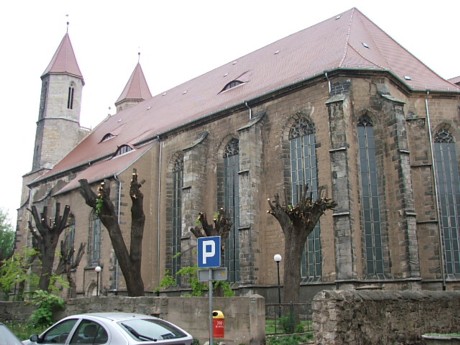
Lwówek Śląski. Church of the Assumption of Mary
Franciscan
The history of this church dates back to the middle of the 13th century. A historical source from 1264 reviews “the construction of a precious stone church”. In the beginning it was a one-ship church, only in the 15th century. a southern and a northern side ship were added. After the abolition of the order in 1810, the monastery building became the property of the Prussian state and the church was furnished to the arsenal. The monastery was rebuilt in 1870’and got his current look. In the church building, among other things, fire department for houses, later it became a warehouse for building materials. Only as late as 1995 did the Franciscan Order succeed in a thorough renovation of the church building, saving the building from ruin and rendering it its original appearance. Of the old stonework in the church there is a bas-relief in the northern porch which reproduces the bakery bar's sign, as well as the group “Crucifixion”. Modern decoration, done in connection with the renovation, includes among other things. the main window of the choir, which is adorned with a mosaic pane with a representation of the twelve apostles.

Lwówek Śląski. Franciscan
The Grand Master's Residence of Johannite (Komandoria Joannitów)
The Johannites came to Lwówek in the middle of the 13th century, where they were given special privilege for the parish church. Order's own domicile, viz. The Grand Master's residence was originally a wooden building that burned down and was replaced (unknown when) by the current building. This residence, which had distinctive Renaissance features, was rebuilt in the 18th century, after which it predominantly appears in Baroque style. Until the abolition of the Order in 1810, the building was owned by the Order of Johannite. In 1813, the Russian tsar, Aleksandr I, demolished his neighborhood in this house; since then, Napoleonic army generals lived in the building. In the first half of the 20th century. was a Catholic nursery here, since hospital and home for nuns.
Museum of Brewery in Lower Silesia (Muzeum Dolnośląskiego Browarnictwa)
The museum (which is housed in the brewery's cellar) first opened its doors in July 2010. It is the only one of its kind in Lower Silesia, and around 400 museum objects are gathered here that document the brewery business in Lwówek Śląski. There are also exhibitions with bottles and other equipment from about 40 breweries that previously worked in Lower Silesia. Mention can be made of refrigeration equipment / refrigerator from 1905 and a stainless steel beer barrel from 1935, manufactured for the Hohberg brewery by Krupp’s factories. During the visit, guests will have the opportunity to see how the whole production process is going. The preview of the museum's collections begins with the presentation of an instructive short film. The museum prefers visitors who are organized in groups.
Other listed buildings
In the square, three of the oldest houses are preserved. You will notice the building with the stone carved logs for the bakers in Lwówek from 1494 and a Renaissance portal with the cobblers' logs from 1544. The building now has a pharmacy.
Bridge over Bóbr. This stone bridge arose as early as 1558.
The old coloring.
The Tower of the No Longer Evangelical Church (1846).
The brewery (see below).

The tower of the no longer existing evangelical church
The brewery (Browar)
The history of the beer brewery in Lwówek Śląski dates back to the Middle Ages. In 1209, the sources mention a beer brewery pool in the city. From the same date, a document is only partially preserved, according to which the citizens of the city were granted exclusive rights to beer brewing within a limit of 1 mile. For hundreds of years, the beer was brewed under different conditions and in different places; only in the 18th century. an actual brewery was built where the brewery business could be assembled and the quality of the beer improved. The brewery was built on a land that belonged to the prince's residence in the Middle Ages. From a document dated 1797, it is known that precisely the brewery was by far the largest industrial company in the then Lwówek. In 1871, the brewery was purchased by Julius Hohberg of Kowary, who began modernizing the business so as to continue to increase the quality of the products produced. Hohberg married a woman from Lwówek and settled in the city. The profits that came in selling beer were used extensively by Julius Hohberg to expand the brewery. Two products were made: export beer and dark (strong) beer. In 1904 the company passed to Hohberg's two sons: Edwin and Paul. They bought a plot next to the brewery, where an administration building was being built.
World War II did not hamper beer production. Beer was still supplied to shops, bars and hotels; moreover, the German army purchased considerable quantities for the use of soldiers and officers at the front. During this time, several forced laborers – including Polish – were employed at the brewery. However, production was halted as the Soviet army approached the city. Soviet forces occupied Lwówek in February 1945 and thus took over the brewery. Already in May of that year, production was resumed, initially under Soviet leadership. Just after the war, there was a shortage of Polish professionals in this industry; in the first years, about half of the employees were therefore Germans. Two types of beer were made: “strong” and “fresh”.
Until 1950, the brewery belonged to an industrial association in Wrocław, since then to a brewery association in Jelenia Góra. In 1950’the breweries were modernized; much of the old German equipment was replaced with newer and more efficient equipment. The fermentation room was renewed, in the early 1960s’the refrigeration system was replaced in the early 1970s’a new tapping line was introduced and the brew house was modernized. At an association in 1975 of several breweries in the western part of Lower Silesia, the brewing company was named Legnickie Zakłady Piwowarskie (Legnica Breweries). This association made considerable progress, so that in 1983 both the warehouse and the fermentation room of the Lwówek Śląski brewery could be expanded. Six years later, a new bottling plant was completed, which was completed in 1992.
In the following years, increasing competition in the market caused problems. Various company structures were tried, among other things. through collaboration with a Czech brewery. In 1994, Browary created Karkonoskie SA (Karkonosze Bryggerierne A / S), headquartered in Lwówek, which immediately after the formation introduced 5 new types of beer from the brewery. In spite of all the efforts, things were not going well, and in September 1998 the Jelenia Góra district court had to declare Browary Karkonoskie bankrupt.
In 1999, the brewery and painting in Lwówek was purchased by a German, Wolfgang Bauer. After some renovation work, the new one was opened “Prywatny Browar Lwówek Śląski” (Private Brewery Lwówek Śląski) in July 1999. Later the company name was changed to “Browar Śląski 1209 Sp. z oo” (The Silesian Brewery 1209 Smba).

The beer produced in Lwówek Śląski won in the first years of the 21st century. several awards for good quality, both in Polish and German competitions. But among other things Due to discrepancies between the owner and local authorities, production had to be stopped, and in September 2007 the brewery was declared bankrupt by the commercial court in Jelenia Góra.
In 2008, the county authorities expressed interest in creating a brewery museum in the buildings. At the same time, the brewer Browar Ciechan (from Ciechanów) reported as interested in continuing production. In 2009, an agreement was signed under which Browar Ciechan was to continue the production of beer in Lwówek, while the county was to establish a “Museum of Brewery Activities in Lower Silesia”. The acquisition of the brewery took place in March 2009. Subsequently, a number of renovations and modernizations were completed. The production of beer was resumed in May 2010.
In 2009, during a beer festival, the city was able to celebrate the 800th anniversary of beer production in Lwówek Śląski.
Under the new management the name of the brewery has been changed to: Browar Lwówek 1209 (Brewery Lwówek 1209).
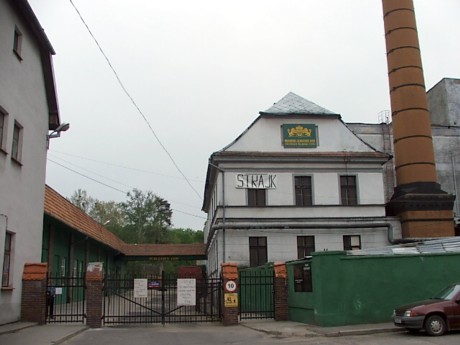
The brewery in Lwówek Śląski. The picture was taken in May 2007. As shown in the strike banner (“Strajk”), there was a strike situation, a strike that was decreed by the then brewer's owner in protest of the circumstances that led to the bankruptcy of the firm later that year.
Surrounding Area
Płakowice
2 km east of Lwowek.
The castle in Płakowice.
Płakowice is one of the oldest settlements in the area and was mentioned in Lwówek’s founding document of 1217, where it was the city property. The later owners of the village were families such as: Raussendorf, Talkenberg, Schaffgotsch, Hohberg and Nostizt as well as – between 1520 and 1812 – the Johanniter Order with domicile in Lwówek. At the transition between the 15th and 16th century. was the site owned by the Talkenberg family, who built a new residence here; Construction was completed in 1550. During the Napoleonic Wars (1813), the castle was significantly damaged and looted. In 1824, the buildings were sold to the Legnica city council for the purpose of setting up a psychiatric clinic here. Until February 1945, the castle housed a branch of the Hospital for Mental Illness in Bolesławiec. After the war, the castle was a. used by the Polish army. In 1992, the building was taken over by the Baptist Church, which decorated it into a rehabilitation center. Since then significant renovation work has been carried out.
Accommodation:
Booking.com
Portal Gminy in Miasta Lwówek Śląski (Official site of the municipality)
Eating Out:
Portal Gminy in Miasta Lwówek Śląski (Official site of the municipality)
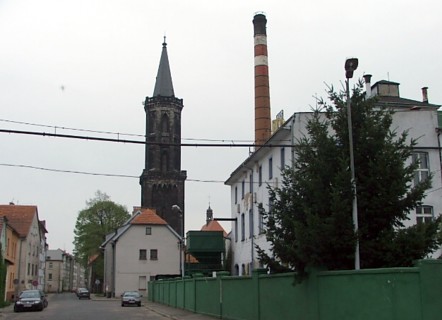
The brewery and the evangelical church tower viewed from the west; between these – in the background – can be seen at the Franciscan Church
Other Internet sites and sources
Portal Gminy in Miasta Lwówek Śląski (Official site of the municipality)
Translated into English by Google Translate. Spangshus.dk accept no liability for any errors or omissions in translation.
Map
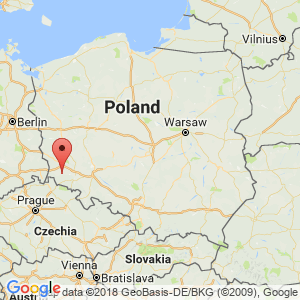
Rating
Search
Most used tags
churches (205) Castles (86) Monasteries (79) Town walls (74) Lakes (71) Town halls (67) Rivers (65) Castles1 (62) Mansions (55) Museums (51) Regional museums (38) Town gates (36) Abbey churches (35) Castle ruins (30) Cathedrals (26) Forests (25) Health resorts (24) Mounds (23) Water sports (23) National parks (22)Click for all tags
Denne side er også tilgængelig på dansk. This page and contents is (c) Copyright 2018- www.spangshus.dk. Based on Inviator software by ISCA Software